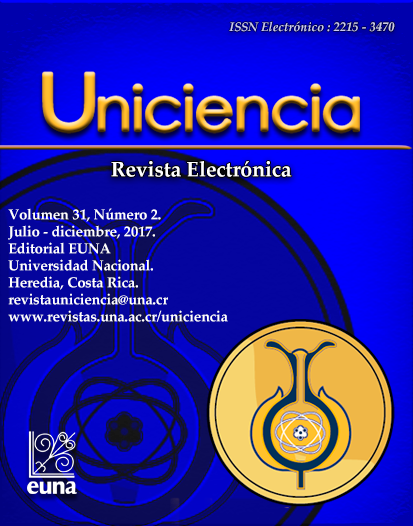Brief Assessment of the Presence of Diatoms and Their Relationship with Some Physical and Chemical Parameters in the Pirro River, Heredia, Costa Rica
DOI:
https://doi.org/10.15359/ru.31-2.7Keywords:
Costa Rica, Urban areas, Wealth, CompositionAbstract
The assessment of water quality in river ecosystems located in urban areas in the tropics based on the use of diatoms is scarce. This exploratory study aimed to establish the composition and species richness of diatoms in relation to physicochemical parameters as base element for monitoring the Pirro urban micro-watershed river in Heredia, Costa Rica. Materials were collected in the upper, middle, and lower river during dry, rainy, and transitional seasons. Dissolved oxygen, pH, conductivity, temperature, and composition diatomaceous were evaluated by scraping an area of 20 cm x 20 cm rocks. 18 diatom species with low abundance such as Navicula seminulum, N. minimum and N. cryptotenella were observed. These are indicatives of moderate conditions of pollution; others kinds, such as Nitzschia, display tolerant species to contaminants. The greatest diversity of species of diatoms occurred in the rainy season, and significant differences between sampling season and species richness were observed. In conclusion, Pirro river has poor sanitary conditions based on the presence of many different species, and the low channel of the river is the most affected by pollution. However, it is necessary to boost the information on this subject.
References
Alonso, A. (2006). Valoración del efecto de la degradación ambiental sobre los macroinvertebrados bentónicos en la cabecera del río Henares. Ecosistemas 15(2),102-105.
Ballestero, M. (2003). Tárcoles River Basin Costa Rica. Background Paper. Recuperado de http://siteresources.worldbank.org/INTSAREGTOPWATRES/Resources/CostaRica_Tarcoles_Background_FINAL.pdf
Blanco, S., Bécares, E., Hernández, N., & Ector, L. (2007). Evaluación en la calidad de agua en los ríos de la cuenca del Duero mediante índices diatomológicos. Ingeriería Civil 146, 139-143.
Fenoglio, S., Badino, G., & Bona, F. (2002). Benthic macroinvertebrate comunities as indicators of river environment quality: an experience in Nicaragua. Revista. Biología Tropical, 50(3/4), 1125-1131.
Goulart, M. & Callisto, M. (2003). Bioindicadores de qualidade de água como ferramenta em estudos de impacto ambiental. Revista da FAPAM, 2(1).
Kelly, M. (2000). Identification of common benthic diatoms in rivers. Field Studies 9, 583-700.
Michels, A. (1998). Use of diatoms (Bacillariophyceae) for water quality assessment in two tropical streams in Costa Rica. Revista BioIogía. Tropical, 46(Supl. 6), 143-152.
Miranda, O., Solano, V. y Balmaceda, G. (2010). II Taller: Construyendo acciones para la recuperación del río Pirro, Costa Rica. Universidad Nacional.
Naumoski, A. & Mitreski, K. (2010). Classifying diatoms into trophic state index classes with novel classification algorithm. Procedia Environmental Sciences 2, 1124–1138. http://dx.doi.org/10.1016/j.proenv.2010.10.122
Penalta–Rodríguez, M. & López-Rodríguez, M. C. (2007). Diatomeas y calidad del agua de los ríos del macizo central Gallego (Ourense, N.O. España) mediante la aplicación de índices diatomológicos. Limnetica, 26(2), 351-358.
Rice, E., Baird, R., Eaton, A & Clesceri, L. (2012). Standard Methods for the Examination of Water and Wastewater (22th Ed.). Washington, USA.
Romero, M. (2008). Diagnóstico físico-ambiental de la microcuenca del río Pirro. Informe final de Proyecto. Escuela de Ciencias Geográficas, Universidad Nacional-Costa Rica.
Romero, M., Piedra L., Villalobos, R., Marín, R. y Núñez, F. (2011). Evaluación ecológica rápida de un ecosistema urbano: El caso de la microcuenca del río Pirro, Heredia, Costa Rica. Revista Geográfica América Central, 47(2), 41–70.
Sabater, S., Sabater, F. & Tomas, X. (1987). Water quality and diatom communities in two catalan rivers. Water Research, 21(8), 901–911. http://dx.doi.org/10.1016/S0043-1354(87)80007-6
Siqueiros-Beltrones, D., Argumedo-Hernández, U., Murillo-Jiménez, J., y Marmolejo-Rodríguez, A. (2014). Diversidad de diatomeas bentónicas marinas en un ambiente ligeramente enriquecido con elementos potencialmente tóxicos. Revista Mexicana de Biodiversidad 85, 1065-1085. http://dx.doi.org/10.7550/rmb.43748
Silva-Benavides, M., Sili, C. & Torzillom, G. (2008). Cyanoprocariota y microalgas (Chlorophyceae y Bacillariophyceae) bentónicas dominantes en ríos de Costa Rica. Revista Biología. Tropical 56(4), 221-235.
Springer, M. (2010). Biomonitoreo acuático. Revista Biología Tropical, 58(supl), 4.
Werner, D. (1977). The Biology of Diatoms. University of California Press. Los Angeles, California.
Wang, J., Liu, X. D. & Lu, J. (2012). Urban River Pollution Control and Remediation. Procedia Environmental Sciences 13, 1856-1862. http://dx.doi.org/10.1016/j.proenv.2012.01.179
Downloads
Published
Issue
Section
License
Authors who publish with this journal agree to the following terms:
1. Authors guarantee the journal the right to be the first publication of the work as licensed under a Creative Commons Attribution License that allows others to share the work with an acknowledgment of the work's authorship and initial publication in this journal.
2. Authors can set separate additional agreements for non-exclusive distribution of the version of the work published in the journal (eg, place it in an institutional repository or publish it in a book), with an acknowledgment of its initial publication in this journal.
3. The authors have declared to hold all permissions to use the resources they provided in the paper (images, tables, among others) and assume full responsibility for damages to third parties.
4. The opinions expressed in the paper are the exclusive responsibility of the authors and do not necessarily represent the opinion of the editors or the Universidad Nacional.
Uniciencia Journal and all its productions are under Creative Commons Atribución-NoComercial-SinDerivadas 4.0 Unported.
There is neither fee for access nor Article Processing Charge (APC)






